Vosoritide
| Clinical data | |
|---|---|
| Other names | BMN-111 |
| Routes of administration | Subcutaneous injection |
| ATC code |
|
| Identifiers | |
| CAS Number |
|
| ChemSpider | |
| UNII | |
| KEGG | |
| Chemical and physical data | |
| Formula | C176H290N56O51S3 |
| Molar mass | 4102.78 g·mol−1 |
| 3D model (JSmol) | |
Vosoritide (INN, codenamed BMN-111) is an experimental drug for the treatment of achondroplasia, the most common cause of dwarfism. It is being developed by BioMarin Pharmaceutical and, being the only available causal treatment for this condition, has orphan drug status in the US as well as Europe. As of September 2015, it is in Phase II clinical trials.[1][2]
Mechanism of action[]

B: Vosoritide (BMN 111) blocks this mechanism by binding to the atrial natriuretic peptide receptor B (NPR-B), which subsequently inhibits the MAPK/ERK pathway at the RAF-1 protein.[3]
Fibroblast growth factor receptor 3 (FGFR3) is a receptor that normally down-regulates cartilage and bone growth when activated by one of the proteins known as acidic and basic fibroblast growth factor. It does so by inhibiting the development (cell proliferation and differentiation) of chondrocytes, the cells that produce and maintain the cartilaginous matrix which is also necessary for bone growth. Children with achondroplasia have one of several possible FGFR3 mutations resulting in constitutive (permanent) activity of this receptor, resulting in overall reduced chondrocyte activity and thus bone growth.[3]
The protein C-type natriuretic peptide (CNP), naturally found in humans, reduces the effects of over-active FGFR3. Vosoritide is a CNP analogue with the same effect but prolonged half-life,[3] allowing for once-daily administration.[2]
Chemistry[]
Vosoritide is an analogue of CNP. It is a peptide consisting of the amino acids proline and glycine plus the 37 C-terminal amino acids from natural human CNP. The complete peptide sequence is
with a disulfide bridge between positions 23 and 39 (underlined).[4] The drug must be administered by injection as it would be rendered ineffective by the digestive system if taken orally.
Research[]
Vosoritide has resulted in increased growth in a clinical trial with 26 children. The ten children receiving the highest dose grew 6.1 centimetres (2.4 in) in six months, compared to 4.0 centimetres (1.6 in) in the six months before the treatment (p=0.01).[5] The body proportions, more specifically the ratio of leg length to upper body length – which is lower in achondroplasia patients than in the average population – was not improved by vosoritide, but not worsened either.[1][6]
As of September 2015, it is not known whether the effect of the drug will last long enough to result in normal body heights,[6] or whether it will reduce the occurrence of achondroplasia associated problems such as ear infections, sleep apnea or hydrocephalus. This, together with the safety of higher doses, is to be determined in further studies.[2]
Side effects[]
The drug was tolerated well in this study. Side effects were generally mild and included reactions at the injection site, headache, low blood pressure, back pain, and cough. One incidence of dizziness, possibly related to low blood pressure, was reported; the other cases of low pressure passed without symptoms or treatment.[5]
Society and culture[]
Some people with achondroplasia, as well as parents of children with this condition, have reacted to vosoritide's study results by saying that dwarfism is not a disease and consequently does not need treatment.[7]
References[]
- ^ Jump up to: a b Spreitzer H (6 July 2015). "Neue Wirkstoffe – Vosoritid". Österreichische Apothekerzeitung (in German) (14/2015): 28.
- ^ Jump up to: a b c Clinical trial number NCT02055157 for "A Phase 2 Study of BMN 111 to Evaluate Safety, Tolerability, and Efficacy in Children With Achondroplasia (ACH)" at ClinicalTrials.gov
- ^ Jump up to: a b c Lorget F, Kaci N, Peng J, Benoist-Lasselin C, Mugniery E, Oppeneer T, et al. (December 2012). "Evaluation of the therapeutic potential of a CNP analog in a Fgfr3 mouse model recapitulating achondroplasia". American Journal of Human Genetics. 91 (6): 1108–14. doi:10.1016/j.ajhg.2012.10.014. PMC 3516592. PMID 23200862.
- ^ "International Nonproprietary Names for Pharmaceutical Substances (INN): List 112" (PDF). WHO Drug Information. 28 (4): 539. 2014.
- ^ Jump up to: a b "BMN 111 (vosoritide) Improves Growth Velocity in Children With Achondroplasia in Phase 2 Study". BioMarin. 17 June 2015.
- ^ Jump up to: a b "Vosoritid" (in German). Arznei-News.de. 20 June 2015.
- ^ Pollack A (17 June 2015). "Drug Accelerated Growth in Children With Dwarfism, Pharmaceutical Firm Says". The New York Times.
- Drugs not assigned an ATC code
- Orphan drugs
- Dwarfism
